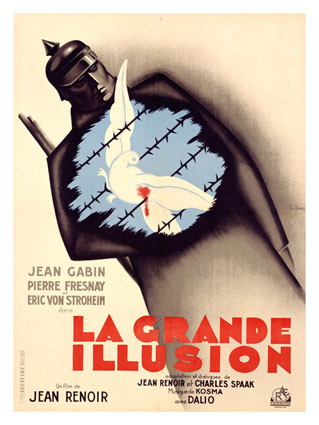 La Grande Illusion Poster |
Illusion takes place during a time of epic cultural change, the first World War. The French Revolution has produced a burgeoning middle-class and the advent of modern warfare meant a new definition of honor in battle. Noblemen and commoners were forced into fraternization.
The opening scene seems almost satirical. The German fighter pilot, Captain von Rauffenstein, has just shot down his twelfth opponent. After a celebratory shot of liquor, his first priority is to have someone retrieve the officers in the enemy plane and bring them to dinner.
One of these French officers is Captain de Boeldieu, and Rauffenstein recognizes his noble name. The respect these two combatants exhibit to one another harkens back to an etiquette of warfare we do not associate with WWI. Marechal, Boeldieu’s pilot, is much more rough, not a nobleman, but a grunt, and his approach to life as a prisoner of war will more closely resemble our modern paradigms.
Life at the prison camp also holds many surprises to modern audiences. Boeldieu complains to a guard about the rude manner in which body searches are conducted, and warns that if the guards are not more polite, their superiors will hear about it. Not only is this warning is taken quite seriously, but we also find that the Germans allow the prisoner’s families to send care packages, stuffed with delicacies, while the guards eat cabbage every night.
In the prison camp, noblemen like Boeldieu and grunts like Marechal are thrown together, adapting to one another’s cultures. One grunt marvels at the fine dinning the upperclassmen insist upon. Similarly, Boeldieu joins in the camaraderie of helping the grunts in their efforts to dig a tunnel out of their prison. The consequence of getting caught outside the prison walls is to be shot on sight.
 Captain De Boeldieu and Captain von Rauffenstein |
Boldieu and Rauffenstein meet again. Rauffenstein bares the scars of a hardened veteran, Boldieu’s scar’s are more subtle, expressed through his character and his stiffness in relation to Rauffenstein. Rauffenstein sees them as equals, but Boldieu’s perspective is more modern. Their dialogues are thoughtful, reflective of the changing times.
Jean Renoir’s masterpiece is prophetic, filmed as it was before WWII. The Nazi’s considered the film subversive due to its message of racial, class, and social equality and its portrayal of war as futile. Goebbels condemned it as “Cinematic Public Enemy No. 1.” Ironically, by confiscating the negatives of the film, the Nazi’s ensured its survival as an Allied raid destroyed one of the leading Paris laboratories, where the negative was thought to be stored.
Lucky for the world, as there are so many great moments throughout the film. The reaction of the prisoners to one of their own dressed as a woman. An enlightening conversation between the prisoners of differing social statuses about various diseases spreading across classes, where Boldieu comments that he believes cancer will not stay confined to Aristocratic Society. Boldieu’s and Rauffenstein’s final dialogue, which seems almost farcical, if we did not know their characters so well.
Beyond the story elements there is Renoir’s subtle and not-so-subtle use of symbolism. There is the flower in the prison representing Boldieu, the lone thing of beauty among the castle’s “ivy and nettles,” and the too big table at the farm. The humanity of the story emphasized through Renoir’s camera work, which dances intimately between the characters, drawing the audience into their discussions.
Many film critics consider Illusion the greatest war film ever made, other consider it the greatest film ever made. Perhaps it is the simplicity of its message that makes it so profound. The Great Illusion is war, and by observing the individuals caught up in it, the futility of its endeavors cut through its false promises.
See Also: The Life and Death of Colonel Blimp